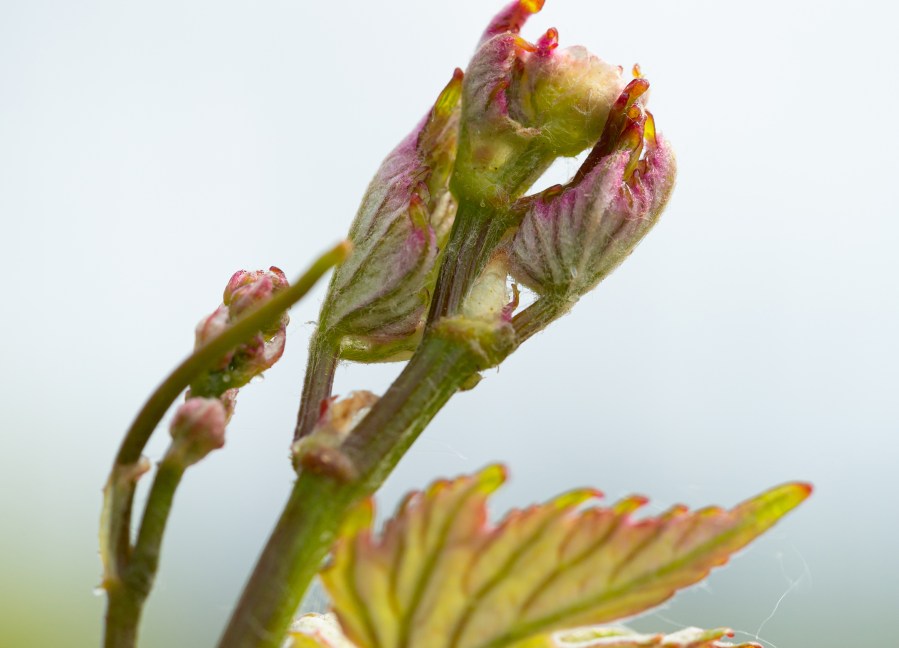Vines are particularly susceptible to disease infection during flowering and immediately after, so Hutchinsons agronomists Rob Saunders and Chris Cooper offer some seasonal advice to help protect crops.
Flowers and inflorescences where the caps don’t dislodge provide an ideal entry point for fungal pathogens; a risk that is exacerbated by the unsettled conditions that so often coincide with ‘Wimbledon fortnight’.
Phomopsis, downy mildew, powdery mildew, and Botrytis are the four key diseases to prevent getting established, although for Botrytis, the benefits of preventing infection now may not become apparent until later in the season.
Latent Botrytis infection at flowering remains ‘hidden’ until developing berries begin to soften in late summer/early autumn, when the concentration of natural anti-fungal compounds declines, and disease develops, causing rots to occur.
Wet and warm conditions at flowering greatly increase the risks from Botrytis and downy mildew, and prolong the flowering process itself, creating more opportunities for infection. In warm, dry conditions, flowering is over very quickly, whereas cooler, wetter conditions could extend it for up to three weeks.
Control options
The UK weather is inherently unpredictable, so given the sensitivity of this critical growth phase, a prophylactic approach is best.
In low disease pressure scenarios, a well-timed application of kresoxim-methyl may offer sufficient all-round protection, given its activity against powdery mildew, Botrytis and Phomopsis.
Where risk is higher, stronger protectant chemistry is needed, which in the case of Botrytis, generally centres around cyprodinil + fludioxonil, fenhexamid, and pyrimethanil. In protracted flowering seasons, it may be necessary to alternate these actives within a three-spray programme at early, middle and late flowering. Indeed, alternating actives and mode of action is important stewardship within any fungicide programme.
A good range of products offer protection against Powdery mildew, with proquinazid and metrofenone being the stand-out choices, while sulphur plus tebuconazole, or trifloxystrobin plus tebuconazole, are good in moderate disease pressure situations, or where growing PIWI or hybrid cultivars; the sulphur providing powdery mildew control, and the trifloxystrobin and/or tebuconazole giving some powdery mildew and Botrytis control, plus additional wound protection.
Potassium bicarbonate and sulphur-based products are best avoided during flowering as experience suggests they can be harsher on flowers and reduce pollination.
Downy mildew options are somewhat more limited, with ametoctradin + dimethomorph being the main fungicide choice.
Integrated controls
It is always important to support chemistry with cultural disease control measures, which include careful canopy management and supporting plant health with targeted nutrition.
Dense canopies of lush, ‘sappy’ growth create ideal conditions for diseases, and prevent sprays penetrating through to the forming bunches, so thinning and reducing shoot number and density can benefit disease control greatly. Exposure of lush, dank areas through leaf stripping to UV light is also an excellent way of reducing powdery mildew.
Excessive nitrogen fuels canopy growth, particularly where it is applied in readily-available foliar forms. Applying non-nitrate based feeds around flowering is advantageous, as it helps ‘toughen’ the cell walls within leaves and removes the nitrogen element responsible for generating excess sappy growth, reducing the risk of mildew or Botrytis.
Targeted nutritional products can also help by building plant health and natural disease resistance. Cultigrow (CBL), for example, is based on flavonoids, and in AHDB trials and empirical observations, appears to reduce powdery mildew incidence due to improved plant health.
Similarly, the foliar phosphite and biostimulant Phorce, where used regularly, helps build resilience to downy mildew, so is a useful addition where fungicide options are very limited. Equally, calcium is known to help reduce Botrytis risk due to its role in building stronger cell walls.
More growers are taking this plant health concept further by incorporating biofungicides or elicitors, such as Romeo, Fytosave or Prestop, into programmes, to boost natural defences and support, or even supplement conventional chemistry.
Look out for black spot
While the ‘big four’ dominate disease control programmes, it is always worth looking out for any potential new threats, such as black spot, or anthracnose, caused by the Elsinoe ampelina fungus.
It is an important wet weather disease globally, particularly in humid areas, and although not something many UK or European growers have had to worry about to date, cases were seen in Kent last year, and it may be going undiagnosed elsewhere.
The four weeks after cap fall are the main infection period, with warm, humid weather increasing risk. Existing triazoles such as tebuconazole or penconazole, and other actives including kresoxim-methyl or myclobutanil, are effective against black spot, so consider tweaking programmes to ensure this post-cap fall period is sufficiently protected.
Many plant protection products have caveats regarding their usage, so always familiarise yourself with the label requirements and/or discuss with your advisor before use.
This story was taken from the latest issue of Vineyard. For more up-to-date and in-depth reports for winemakers and growers in Great Britain, read our latest issue here and subscribe here.




